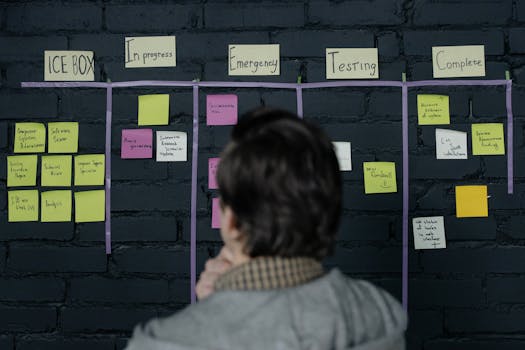🌀 Agile & Scrum Basics: Deliver Faster, Collaborate Better
🧾 Course Description
In today’s fast-paced digital world, Agile and Scrum have become the go-to methodologies for managing software projects efficiently and flexibly. “Agile & Scrum Basics” introduces you to the core principles, roles, ceremonies, and tools that define Agile project delivery — with a deep focus on Scrum.
This beginner-friendly course is designed for developers, testers, product owners, project managers, or anyone entering a team working in Agile. You’ll learn how to work in sprints, plan effectively, hold daily stand-ups, write user stories, and deliver business value consistently — with hands-on scenarios and team simulations.
✅ Key Benefits
- 🧠 Understand Agile Mindset — Deliver in iterations, embrace change, and focus on value
- 🧩 Master Scrum Roles and Ceremonies — Work smoothly as a dev, PO, or Scrum Master
- 📅 Improve Productivity — Plan better with backlog grooming, estimation, and retrospectives
- 🤝 Enhance Collaboration — Clear communication, ownership, and teamwork culture
- 💼 Industry-Aligned Skills — Get prepared for Agile teams, interviews, and certifications (CSM/PSM)
🎯 Pre-requisites
- No prior Agile or project management knowledge required
- Basic understanding of software teams helpful but not necessary
- Suitable for non-tech, tech, and hybrid roles
📚 Curriculum Breakdown
🧭 Module 1: Agile Fundamentals
- What is Agile? Manifesto and principles
- Agile vs Waterfall
- Agile values: collaboration, feedback, working software
🌀 Module 2: Scrum Framework Overview
- What is Scrum? When and why to use it
- Scrum roles: Product Owner, Scrum Master, Development Team
- Scrum events: Sprint, Sprint Planning, Daily Stand-up, Review, Retrospective
🗂️ Module 3: Product Backlog & Sprint Planning
- Writing user stories and acceptance criteria
- Prioritization techniques: MoSCoW, WSJF
- Estimation: Story points, Planning Poker
📈 Module 4: Sprint Execution & Delivery
- How Daily Stand-ups work
- Definition of Done (DoD) and Definition of Ready (DoR)
- Burn-down charts and task boards (Jira, Trello)
🔁 Module 5: Review, Feedback & Retrospective
- Sprint review for demo & validation
- How to conduct retrospectives effectively
- Continuous improvement mindset
🛠️ Module 6: Tools, Artifacts & Real-Life Scenarios
- Scrum artifacts: Product backlog, Sprint backlog, Increment
- Tools: Jira, Trello, Miro (overview)
- Scrum in remote/hybrid teams
🧪 Module 7: Agile Simulation Project
- Participate in a simulated Agile sprint
- Write stories, conduct planning, review and retro
- Evaluate team velocity and reflect
⏱️ Estimated Duration
| Daily Study Time | Estimated Duration | Best For |
|---|---|---|
| 2 hours/day | 7–8 days (~1.5 weeks) | Smooth daily pace with exercises |
| 4 hours/day | 3–4 days | Great for onboarding or crash course |
| 6 hours/day | 2–3 days (bootcamp) | Ideal for rapid team training |
🎓 Outcome
By the end of Agile & Scrum Basics, you will:
- Understand how Agile and Scrum work in real teams
- Take part in sprint ceremonies and contribute effectively
- Use Jira/Trello to manage tasks and track progress
- Be prepared for Agile job roles, Scrum interviews, or CSM/PSM certification



